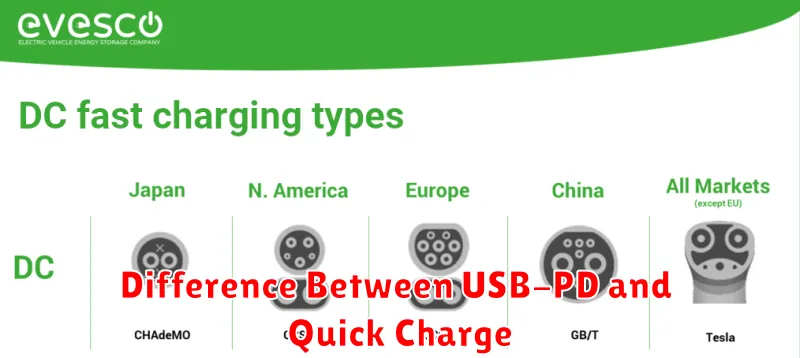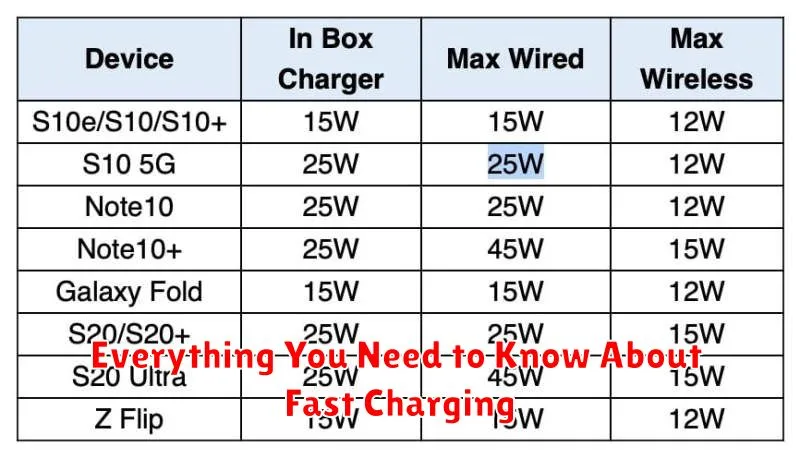In today’s fast-paced world, keeping our devices powered up is more crucial than ever. Fast charging has emerged as a vital technology, allowing us to quickly replenish our batteries and minimize downtime. This article will delve into everything you need to know about fast charging, exploring the intricacies of this technology, its benefits, potential drawbacks, and compatibility with various devices. Understanding the nuances of fast charging standards, charging speeds, and battery health considerations will empower you to make informed decisions about how you power your devices and ensure their longevity.
From USB Power Delivery (USB PD) to proprietary fast charging protocols, the landscape of fast charging can be complex. We’ll demystify these technologies, explaining the key differences between various fast charging methods and highlighting their respective advantages. Whether you’re using a smartphone, tablet, laptop, or electric vehicle, fast charging plays an increasingly important role. This comprehensive guide will provide you with the knowledge necessary to navigate the world of fast charging and optimize your charging experience.
What Is Fast Charging Technology?
Fast charging technology allows compatible devices to charge significantly faster than standard charging. It involves delivering higher currents and/or higher voltages to the device’s battery, reducing the time required to reach a full charge.
Several factors influence fast charging speeds, including the device’s charging circuitry, the charger’s power output, and the cable’s quality. Not all devices support all fast charging standards. Using an incompatible charger or cable may result in slower charging speeds or, in some cases, could damage the device.
It’s important to differentiate between fast charging technologies, as different manufacturers utilize varying standards, each with specific requirements and limitations.
Common Fast Charging Standards
Several prominent fast charging standards exist in the market, each with its own specifications and compatibilities. Understanding these standards is crucial for selecting appropriate chargers and devices.
USB Power Delivery (USB PD) is a versatile standard supporting a wide range of voltages and wattages, making it compatible with various devices from laptops to smartphones. It dynamically negotiates power delivery for optimized charging.
Qualcomm Quick Charge is another popular standard, predominantly found in Android devices. Different Quick Charge versions offer varying charging speeds.
Other standards include Adaptive Fast Charging by Samsung, and SuperCharge by Huawei. These proprietary standards offer optimized fast charging for their respective devices.
Does Fast Charging Damage the Battery?
Fast charging, while convenient, does contribute to slightly increased battery degradation compared to standard charging. This is due to the higher heat generated during the process. However, modern smartphones incorporate sophisticated battery management systems designed to mitigate these effects.
These systems monitor temperature and adjust charging speeds to prevent overheating. While some long-term wear is inevitable with any charging method, the impact of fast charging on modern batteries is generally considered minimal and often outweighed by the benefits of quickly topping up your device’s power.
Key takeaway: Fast charging does contribute to some battery wear, but the impact is relatively small with modern technology.
Difference Between USB-PD and Quick Charge

USB Power Delivery (USB-PD) and Quick Charge are both fast charging technologies, but they differ in their approach. USB-PD is a standard developed by the USB Implementers Forum, while Quick Charge is proprietary to Qualcomm.
A key difference lies in their voltage and current handling. USB-PD supports higher power delivery (up to 100W) and a wider range of voltages, making it suitable for charging larger devices like laptops. Quick Charge, while generally faster for phones, primarily focuses on increasing current.
Another important distinction is compatibility. USB-PD is designed to work with a broader range of devices and utilizes the USB-C connector. Quick Charge, on the other hand, requires specific Qualcomm chipsets in both the charger and the device.
Tips to Maximize Charging Speed
To ensure you are getting the fastest charging speeds possible, consider these tips:
Use the correct charger and cable. Your device manufacturer likely recommends specific charging accessories. Using off-brand or lower-powered options can significantly reduce charging speed.
Reduce background activity. Close unnecessary apps running on your device. Minimizing tasks like streaming or gaming can free up resources and allow for faster charging.
Enable Airplane Mode or turn off your device completely. This eliminates network communication which can consume power and slow down charging.
Keep your device cool. High temperatures can negatively impact charging speed and battery health. Avoid charging in direct sunlight or hot environments.
Compatible Phones and Chargers
Not all phones and chargers support fast charging. Compatibility is crucial for effective fast charging. Using an incompatible charger can result in slow charging or even damage to the device. Always check your phone’s specifications to determine its fast charging capabilities and the compatible charging standards.
Phone Compatibility: Different phone manufacturers implement different fast charging technologies. Some popular standards include Qualcomm Quick Charge, USB Power Delivery (USB PD), and proprietary technologies like Samsung Adaptive Fast Charging and OnePlus Warp Charge. Your phone must support a specific standard to utilize its benefits.
Charger Compatibility: To achieve fast charging, you need a charger that supports the same fast charging standard as your phone. Using a standard charger with a fast-charging-compatible phone will result in standard charging speeds. Make sure the charger’s wattage (power output) is also sufficient for your phone’s fast charging needs.

